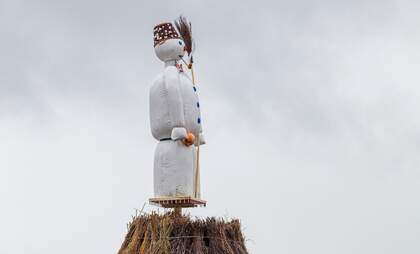Sechseläuten: Why is Zurich setting fire to a snowman next Monday?
If you are in Zurich on April 28, you may see some peculiar sights. From exploding snowmen to cavalry circling a burning effigy of a medieval bogeyman, Sechseläuten is truly something to behold.
What is Sechseläuten in Zurich?
Sechseläuten is a cantonal holiday in Zurich, celebrated by most of the city's population. Some international companies and local businesses give Sechseläuten as a day off for their employees, and people in many other Swiss cantons visit the city to see the festivities.
The name Sechseläuten is a fusion of two separate words, sechse leuten, meaning six rings. When combined together, the event roughly translates as the “six o'clock ringing of the bells.”
The celebration is put on by Zurich’s guild societies. Lining the Limmatquai in the city, each guild (Zunft) specialises in a certain industry, from the Zunfthaus zur Saffran (spices) to the Zunfthaus zur Schmiden (smiths).
Image: Shutterstock.com / Agnieszka Skalska;
The event itself is a march through the city by the various guilds, whose members dress in costumes and uniforms from medieval times. As they march through the town, music ensembles are played, flowers are given out and flags fly. Once the parade has finished, people gather at Sechseläuten square opposite the Zurich Opera House to watch a giant snowman called the Böögg be burnt, symbolically burning what remains of winter, as cavalry ride around the pyre.
The scarecrow's head is packed with explosives, so when the fire reaches the top of the snowman, the head explodes and the event ends. Local folklore has it that the quicker the head explodes, the better the weather will be.
History of Sechseläuten
This rather unusual festival originated when working hours were strictly regulated by the city government and the guilds during the medieval period. During the winter, workers did their jobs for as long as the sun was in the sky, leading to less time off.
As the days grew longer, workers were no longer needed during all daylight hours. Sechseläuten was the day workers switched from winter to summer hours. From this day until the end of summer, work ended at the six o'clock ringing of the bells, as opposed to sundown. This was a reason to celebrate for the city’s residents, who now had some time off while there was still daylight.
The festival has been held in the city for hundreds of years, but the official ceremony as we know it today only came with the addition of the Böögg in 1902. In 1951, the date of the festival was moved from the first Monday after the vernal equinox - when the sun is pointed directly at the equator - to the third Monday in April. However, this date is not set in stone, with Sechseläuten in 2025 taking place on the fourth Monday (April 28).
What is the Böögg?
The Böögg (also known as the bogeyman) developed separately from Sechseläuten itself. In the festival today, the Böögg is a statue made out of straw and thread that resembles a snowman. The head of the Böögg is filled with fireworks and explosives, meant to go off as the figure is burnt. The original figures were scary-looking ragdolls that were placed in different areas of the city and burnt during springtime - meant to symbolise mischief and designed to "scare" children.
The Böögg was incorporated into the Sechseläuten parade in 1902 and has been a staple to this day. Now, the Böögg is erected in Sechseläuten square near Bellevue and Stadelhofen on the Monday of the festival.
What happens on Sechseläuten and when does the snowman explode?
While the weekend of the festival includes many events from concerts to dances and fairs, it is on Monday when Sechseläuten truly comes alive. At 3pm on the Monday of the festival, 3.500 guild members in costumes and uniforms begin a procession through the old part of Zurich.
Procession through Zurich by the guilds
These guild members are joined by 350 to 400 riders on their route from Bürkliplatz down Bahnhofstrasse before crossing the river and coming back along the Limmatquai to Sechseläuteplatz. The procession is lined with stands of people so they can see the colourful costumes and high-class regalia.
Image: Shutterstock.com / Michael Derrer Fuchs
Burning of the Böögg
At 6pm, once the procession arrives at the square, the process of burning the Böögg can begin. The fireworks and explosives in the Böögg's head are meant to go off when the fire reaches its peak. As the Böögg burns, cavalrymen circle the pyre and thousands line the streets to see the event. Once the explosion happens, the event officially ends but many choose to stay and party on.
Can the Böögg predict the weather in Switzerland?
Popular legend has it that the Böögg is actually able to predict the weather in Switzerland. The idea being: the longer the Böögg takes to burn and explode, the worse the summer weather will be. The longest time it has taken to explode was 43 minutes and 34 seconds in 2016, allegedly setting off a bad summer for Switzerland. The shortest time was five minutes and seven seconds, recorded in 1974.
Sechseläuten one of the top Swiss holidays and traditions
Sechseläuten is one of the defining symbols of the city of Zurich. Like Fasnacht in Basel and Fête de l'Escalade in Geneva, it is a tradition that has survived and stood, mostly intact, for hundreds of years.
Video: DW Euromax / YouTube



COMMENTS
Leave a comment